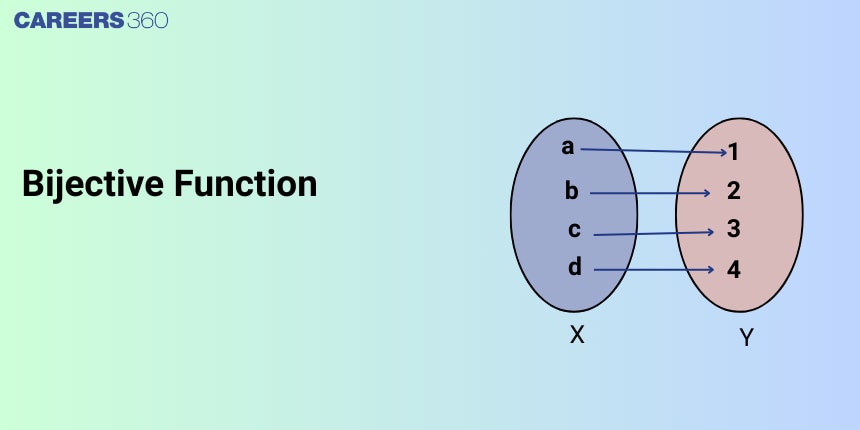Into Function and Bijective Function: Definition & Differences
Functions can be defined as the relation between two sets where every element in one set has a unique element in another. A bijective functions are one of an important topic in set theory and Mathematics. These concepts are used in various fields like calculus, physics, engineering etc.
In this article, we will cover the concepts of bijective function. This concept falls under the broader category of sets relation and function, a crucial Chapter in class 11 Mathematics. It is not only essential for board exams but also for competitive exams like the Joint Entrance Examination (JEE Main), and other entrance exams such as SRMJEE, BITSAT, WBJEE, BCECE, and more. Over the last ten years of the JEE Main exam (from 2013 to 2023), a total of seven questions have been asked on this concept, including one in 2019, one in 2021, one in 2022, and four in 2023.
JEE Main 2025: Sample Papers | Mock Tests | PYQs | Study Plan 100 Days
JEE Main 2025: Maths Formulas | Study Materials
JEE Main 2025: Syllabus | Preparation Guide | High Scoring Topics

Function
Domain of a function
All possible values of
If a function is defined from
Co-domain of a function
If a function is defined from
Range of a function
It is defined as all the values that the function assumes or in other words we can also say the output of the given function. It is also known as the image set of the function.
Injective function(one-one function)
A function
Eg.

Surjective Function(onto function)
A function
Eg.

Bijective Function
A function
Eg.
Consider,

The function f is a injective function as the every distinct elements in
The number of bijective functions
If
While mapping the two functions, i.e., the mapping between
- each element of
- no element of
- each element of B must be paired with at least one element of
- no element of B may be paired with more than one element of
Difference between Injective, Surjective, and Bijective Function
S.No | Injective Function | Surjective Function | Bijective Function |
| 1 | A function that always maps the distinct element of its domain to the distinct element of its codomain | A function that maps one or more elements of | A function that is both injective and surjective |
| 2 | It is also known as one-to-one function | It is also known as onto function | It is also known as one-to-one correspondence |
| 3 |  |  |  |
Some examples of Bijective functions are:
- Linear functions:
- Polynomial Functions:
- Exponential functions:
- Absolute Value Function:
Properties
- Inverse Exists: A bijective function has an inverse function that undoes the mapping, taking an element from the codomain back to an element in the domain.
- Unique Inverse: The inverse of a bijective function is unique, meaning there is only one function that reverses the mapping.
- Preservation of Composition: If you compose a bijective function with another function, the composition is also bijective.
How to Identify a Bijective Functions?
To figure out if a function is bijective, there is a 2 step process to identify:
- Injective function
- Surjective function
If the give function is both injective and surjective, then it is a bijective function.
Recommended Video Based on Into and Bijective Functions
Solved Examples Based On the Into and Bijective Functions
Example 1: Let
Solution:
As we learned in
Bijective Function -
The function that is both one-on-one and onto is the Bijective Function.
Let
Example 2: If
Solution:
If
Here,
So, bijective functions are not possible.
Hence, the answer is 0 .
Example 3: Which of the following function is a bijective function?
1)
2)
3)
4)
Solution:
Hence, the answer is the option 3.
Example 4: If
1)
2)
3)
4)
Solution:
As we have learned
Number of Bijective Function
If
And the number of Bijective functions
Here, number of bijective function
Hence, the answer is the option 1.
Example 5: If set
1)
2)
3)
4)
Solution:
As we have learned
Number of Bijective Function
If
And the number of Bijective functions
Here
There can be no bijective function from
Hence, the answer is the option 3.
Frequently Asked Questions (FAQs)
Functions are one of the basic concepts in mathematics that have numerous applications in the real world.
All possible values of
If a function is defined from
A function
A function
Also Read
15 Feb'25 02:33 AM
14 Feb'25 10:32 PM
11 Feb'25 11:46 PM
11 Feb'25 11:44 PM
11 Feb'25 11:41 PM
11 Feb'25 11:41 PM
11 Feb'25 06:18 PM
11 Feb'25 05:07 PM
11 Feb'25 05:00 PM
11 Feb'25 03:32 PM

